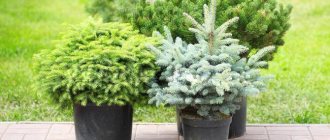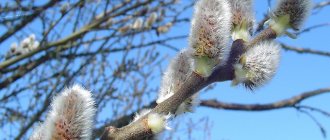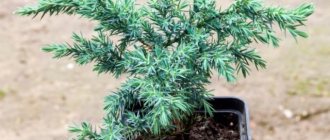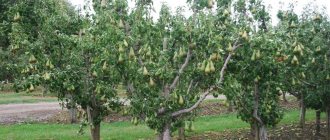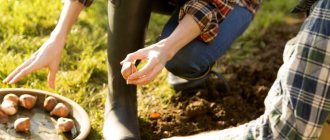When to plant an apple tree in spring
The timing of planting an apple tree in the spring is determined by the climatic conditions of the region. However, two rules remain the same:
- The tree should be at rest, that is, until the buds open.
- Day and night temperatures are optimal for planting +3 – +5 degrees, during the week.
The ground does not have to be warm; it is advisable that it thaws to the point of a shovel.
Planting should be done on a windless, cloudy evening, since the soil is cold in the morning and warmer in the evening. When planting in the evening, the seedling is less susceptible to stress, since it is night ahead and not bright day.
Further care for grafted apple trees
Grafting can be compared to a surgical operation, so the plant must be provided with proper care. First of all, you need to check the bandage and protect it from ants and other pests. As the grafts thicken and grow, it is necessary to periodically loosen the bandage and change it. When the scion is completely fused, the bandage must be removed.
It is recommended to apply phosphorus-potassium fertilizers to grafted apple trees and ensure good watering. In the first year, it is advisable to wrap the grafting site for the winter to protect it from frost damage.
When is it better to plant - spring or autumn
Apple trees are planted both in autumn and spring.
Traditionally, it is believed that it is better to do this in the fall. The plant does not vegetate, it only grows roots, then goes into a winter dormant state. However, after planting, there should be 3-4 weeks left before frost for the seedling to take root and become stronger. Often in the northern regions and the middle zone, frosts come unexpectedly. Under these conditions, a fragile tree may die, and the root system also freezes. Therefore, spring planting is preferable in these regions. In the southern regions it is better to plant apple trees in the fall.
Preparing the planting hole
It is recommended to prepare the hole for autumn planting of an apple tree no later than 3-4 weeks before the procedure. Spring planting also means preparing the hole in the fall. This process consists of several steps:
- formation of a hole 60-70 cm deep and the same diameter;
- combining the soil removed during digging with fertilizers and placing it at the bottom of the hole.
Important! To obtain a fertile composition, the soil from one hole is mixed in equal parts with peat and humus, and 1/2 a bucket of wood ash and 300 g of superphosphate are added.
Features of planting in different types of soil
Since sandstones do not hold water and are not rich in nutrients, it is recommended to create pits as large as possible in this type of soil. In the future, the planted apple trees will need frequent feeding.
To plant apple trees in clay soils, you need holes the same size as for sandstones. In this case, the diameter should be about 150 cm, and the depth should be approximately 70 cm. The resulting hole is lined with a drainage layer: expanded clay, broken brick or crushed stone. To prepare the nutrient mixture, up to 25% of coarse-grained river sand is added to the usual recipe; this solution will provide the soil with a looser structure.
Sequence of planting apple tree seedlings in rocky soil :
- Preparing a hole with a depth of 60-70 cm and the same diameter (a larger size is acceptable).
- Formation of two trenches perpendicular to each other with a length and depth of up to 40 cm, passing through the center of the pit.
- Place the nutrient mixture into the well.
- Production of vertical fascines from rods with a length of 40 cm and a diameter of 3 cm.
- Installation of fascines along 4 trench arms so that the distance between them and the center of the pit is at least 60 cm.
- Planting a seedling.
Benefits of spring planting
Planting in spring in open ground is carried out before the growing season begins and it has several undeniable advantages.
- Throughout the growing season, you can monitor the plant: how it develops, for diseases, and take the necessary measures in time.
- A seedling planted in the spring takes root faster, because in the spring there is more moisture in the soil and the growing season is more active if the planting time is chosen correctly.
- Planting holes can be prepared in the fall to allow the soil to settle in them. This is important for proper placement of the root collar. The development of the tree depends on this.
Over the summer, under control, the tree will get stronger and be ready for the coming winter.
Seedlings with a closed root system (growing in a container) can be planted throughout the growing season, from spring to autumn. The main thing is to choose suitable, cool weather.
Selection of seedlings, varieties
It is important to know how to choose a seedling correctly. When choosing, you need to determine how suitable it is, its ability to grow quickly and bear fruit. If an inexperienced gardener does not know what the signs of a good tree are, the purchased seedling will develop slowly or dry out.
The purchase must be made in fruit nurseries from trusted manufacturers, otherwise there is a high risk of being deceived.
Seedlings that are 1-2 years old are considered suitable. When choosing planting material, you should consider the following aspects:
- The grafting site must be uncontaminated, without roughness, and completely overgrown. The presence of signs indicating damage is unacceptable.
- The roots of a good seedling are moist, easily bending, developed, and branched. If the roots emit an unpleasant odor, have rotting areas or spots of any color, these are bad signs. A tree grown from such a seedling will constantly get sick and will not live long.
- A seedling dug up in advance should be sold with its roots dipped into a clay mash. Another option for maintaining a healthy root system is to wrap it in damp cloth.
- A good seedling has smooth bark, no spots or microcracks.
- Skeletal branches, if any, should extend from the trunk at an angle of 50-90 degrees. If they stretch vertically upward, such a seedling is not worth buying. In the future, such skeletal branches will break under the weight of the harvest, like matches.
- It is better not to purchase a seedling with a large number of leaves and an open root system. Such planting material takes root with difficulty and suffers for a long time.
- If, when buying a seedling in the autumn, it has green bark, this indicates that the accelerated forcing method was used. The seedlings were overfed with nitrogen or treated several times with stimulants. Such seedlings will not meet the gardener's expectations.
When transporting from the nursery, the roots must be protected from drying out. Immediately after delivery of the seedling, you need to begin planting work.
Attention! Seedlings purchased ahead of planting are kept in the soil in a cellar, basement, at a temperature slightly above zero until planting.
Spring planting dates in different regions
Compliance with the deadlines for spring planting is the most important condition for the successful survival of the seedling.
These periods are different in different climatic zones:
- Northern regions of Russia, the Urals, the north of the Leningrad region, Siberia - the approximate dates for planting apple trees are from April 20 to May 15.
- Central and Southern regions - from March 15 to April 15.
- Central Russia - from April 10 to May 10.
If the spring is early and warm, the dates may shift. Temperature and soil conditions should be taken into account.
According to the lunar calendar 2021
No one doubts anymore that the phases of the moon play an important role in the growing season of plants. Many years of experience of gardeners confirms this and recommends choosing certain dates for planting when the Moon has a beneficial effect on a particular crop.
The Lunar calendar for 2021 will help you decide on the date for planting apple seedlings.
Favorable days
- March 26–29;
- April 11–15, 24, 25;
- May 2–10.
It is advisable to choose one of these dates.
During the full moon and new moon, plants freeze, as these days are said to be barren.
Unfavorable days:
- March 9, 19–21, 24;
- April 8, 15–17, 23;
- May 7, 13, 14, 22.
You need to pay attention to these dates and try to choose favorable days for planting apple trees.
Algorithm for spring planting an apple tree: a step-by-step guide on how to plant a seedling correctly
Dreaming of growing a beautiful apple orchard, a gardener must perform several necessary steps and follow several rules. All this will ensure high quality of work and successful survival of seedlings.
Selecting a seedling and preparing it for planting
When purchasing a seedling, you should take into account the area of the garden and the proximity of groundwater.
The root system of the apple tree cannot tolerate stagnant water and the tree dies.
- If groundwater is higher than 2.5 m, you need to choose medium or low-growing varieties of apple trees. Tall trees (6–8 m) have roots that go deep into the soil and cannot withstand stagnant water.
- It is best to select seedlings from a local nursery, where the plants are grafted and adapted to the local climate.
- Two-year-old plants are optimal for planting. Two-year-olds have 2-3 side shoots from the main trunk at an angle of 45, 90 degrees.
- The trunk must be smooth, without growths and scratches up to 1.5 m high.
- The roots are elastic, about 40 cm long. If you pull lightly, the root will begin to stretch, but will not tear.
- The bark should be green when scratched with your fingernail.
- Saplings with an open root system should not have blossoming leaves.
When transporting seedlings with bare roots, wrap them in a wet cloth and cover them with film, carefully pull the branches to the trunk with rope or tape.
You can buy seedlings for spring planting in the fall. To preserve planting material until spring, they can be placed in boxes in the basement, covering the roots with soil, or buried in the garden at an angle of 45 degrees. and cover for the winter with an additional layer of earth and dry leaves.
Preparation for planting seedlings:
- Before planting, you should carefully inspect and cut off rotten roots.
- Place the tree in a container of water for 12 hours before planting; root growth stimulants can be added to the water.
- If the ground part is large and the root system seems weak, you need to trim and shorten the branches before planting.
The main thing in a seedling is a developed and healthy root system. It is better to choose a plant with a large root and a small above-ground part, and not vice versa.
Suitable place in the garden
Apple trees love the sun and elevated places where water does not accumulate or stagnate after rains or melting snow.
If the area is low-lying with close groundwater, you need to make an artificial embankment and then plant trees. The place should be protected from strong winds from the north side by a house or fence. Steep slopes and wetlands should not be used for planting.
At what distance to plant
If you plan to plant several trees, you need to draw up a diagram of the garden before planting. It will be almost impossible to correct mistakes later.
Thickening will lead to a lack of light and a decrease in yield, and will also create conditions for the development of fungal diseases.
- Tall varieties are planted at a distance of 5–7 m from each other.
- Medium height 3–4 m.
- Low-growing and dwarf species are placed 3–1.5 m between seedlings.
- Columnar varieties can be planted at a distance of 0.5 m.
The correct garden layout ensures its development for many years.
Required soil
Apple trees are unpretentious and undemanding to soil if:
- These are not salt marshes;
- all necessary agrotechnical measures were carried out during planting;
- The plantings are regularly maintained and fertilizers are added to the soil.
The ideal soil for an apple orchard is light loam. Therefore, when digging, dilute clay soil with sand 2:1, sandy soil with peat and humus in a ratio of 2:1:1. Read more about soil preparation.
Preparing a planting hole: when to dig and what size
For spring planting, the pit is prepared 2 weeks in advance or in the fall.
| Apple tree type | Depth of planting pit, cm | Planting pit diameter, cm |
| Tall varieties | 70 | 100–110 |
| Medium-sized varieties | 60 | 100 |
| Low growing varieties | 50 | 90 |
In the process of digging holes, the upper, more fertile and lower layers of soil must be divided and placed separately from each other.
How to prepare a nutrient mixture (substrate) for a planting hole
For planting, you need to prepare a nutrient mixture of the following composition:
- 6 kg of compost;
- 200 g superphosphate;
- 150 g potassium chloride;
- 1 kg of dolomite flour if the soil is acidic.
Or an alternative could be this soil mixture:
- compost bucket;
- a bucket of non-acidic peat;
- bucket of sand;
- 400 g nitroammophoska.
Fresh manure should not be used. When decomposed, it releases ammonia and hydrogen sulfide, poisoning the roots.
Landing
A layer of drainage is placed at the bottom of the pit; it can be broken bricks, shards of ceramic dishes, or nut shells.
Next, the hole is filled 1/2 full with alternating layers of fertile soil and a nutrient mixture.
A mound is formed in the hole, into which, slightly retreating from the center, a stake 2 m high is driven. It will serve as a support for the seedling.
The seedling is placed on a hill, the roots are straightened and it is covered with the remaining soil and fertile mixture. In this case, you need to make sure that there are no cavities between the roots. The root collar and grafting site should remain 2–5 cm above ground level.
The soil around the tree should be trampled down and a watering area with a diameter of 1–1.3 m should be formed.
After planting, you need to water the tree generously – 20–25 liters of water.
The tree should be tied to the peg with a figure-of-eight ribbon.
It is better to mulch the tree trunk circle, this will retain moisture in the soil. When mulching, do not cover the trunk, as the bark may support it.
Suitable location on the site
Where to plant an apple tree on the site? The right location determines the growing conditions that affect the health of the plant, life expectancy and productivity.
Basic requirements for a place to plant an apple tree:
- good lighting;
- air circulation;
- absence of drafts;
- protection from winds.
Planting in partial shade can cause low yields and stretch apple trees in height. In addition, such conditions contribute to the formation of dampness, which stimulates the development of various diseases.
Wetlands and places with close groundwater (less than 2 m) are not suitable The ideal option would be a place located on a southern, southwestern or southeastern slope.
Soil Features
Full growth and fruiting of an apple tree is possible only in soil with the following characteristics:
- porosity and looseness of the structure;
- the ability to absorb moisture well and retain it for a long time;
- acidity pH 5.1-7.5;
- absence of salinity, as well as chloride and sulfate salinity;
- total carbonate content – up to 15%.
Sandy loam, loamy and chernozem soils meet these requirements.
Apple tree planting scheme
Apple trees are planted as single trees or in groups, taking into account the distance from each seedling to household buildings and nearest neighbors. For low-growing varieties characterized by a small crown, this interval should be at least 4 m .
The planting of an apple orchard is carried out according to a certain scheme, depending on the varieties of fruit crops. According to experts, it is best to do this in rows in a checkerboard pattern, observing the distance rules (the distance between apple trees when planting):
- for tall varieties with a massive crown - 6-7 m ;
- for columnar ones - 1-1.5 m .
Important! Sufficient spacing between apple trees reduces the risk of disease and pest damage.
Apple tree planting distance from the fence
The distance between planted trees and neighboring fences is regulated by the charters of gardening cooperatives and partnerships or local authorities. Typically this indicator depends on the crop variety:
- for tall varieties of apple trees, the distance to the fence is from 4 m;
- for short people – from 2 m.
Planting seedlings in place of old apple trees
It is unacceptable to plant young trees where old crops grow .
This is due to the depletion of the soil and the accumulation in it of an excess of specific inhibitors secreted by the root system of the old apple tree. In addition, such areas are affected by harmful microorganisms and insects.
Desirable and Undesirable Neighbors
Provided the correct planting pattern is followed, many types of garden crops can be grown near a fruit tree. What you can plant an apple tree next to, and what plants next to it is not recommended, is indicated in the table.
| Suitable neighbors for the apple tree | Unwanted neighbors of the apple tree |
|
|
Planting an apple tree with a closed root system
Seedlings with a closed root system can be planted at any time from spring to autumn.
They are grown in a container and their root system is protected and not damaged. Such plants do not experience stress when transplanted into open ground, since they are planted together with a lump of earth, and if the container is made of peat, then directly with the container.
In the first year after transplantation, their growth slows down slightly due to acclimatization, but then recovers.
The planting technology is no different from ordinary seedlings.
If the seedlings were in a nursery under a roof, they need hardening in the open air for 3 days. You need to take them out into the sun for 2-3 hours, then put them in the shade, and take them under the roof at night.
When planting a seedling with ZKS, it is important to correctly remove it from the container:
- The day before planting, it is necessary to completely wet the earthen ball.
- Remove from the container carefully so as not to damage the small roots, since they are responsible for feeding the plant.
- If the roots have grown to the container, you should carefully cut it off with a sharp knife.
If, instead of a container, the earthen ball is wrapped in a metal mesh, the seedling is planted together with the mesh.
Landing algorithm
Seedlings with open and closed root systems are planted directly into the planting hole with slight differences.
The planting scheme for an apple tree with an open root system should be as follows:
- The bottom of the pit is lined with a drainage layer of broken bricks, pieces of ceramics, and large crushed stone.
- Then fertile soil and one of the above nutrient mixtures are laid out alternately so that the hole is half filled. From these layers a slide is formed, into which a stake 2 m high is driven a little away from the center.
- The tree is placed on a hill, its roots are straightened and carefully sprinkled with fertile soil mixed with a nutrient mixture.
- The earth is compacted so that a small depression with a radius of 50–60 cm is formed around the tree.
- Finally, the trunk is tied to a support and watered abundantly with water (2-3 buckets).
- The area for watering is mulched, not reaching 5 cm from the trunk.
Related article:
How to organize proper care of apple trees to achieve a high yield
Trees with a closed root system are planted in a similar way, but together with an earthen ball, which must first be correctly removed from the container. To do this you need:
- a day before performing work, fill it completely with water;
- then carefully remove without damaging the small roots;
- if there are roots attached to the container, then the walls are cut off without tearing the roots off them.
A lump of earth, located in a metal mesh, is planted with it.
Planting an apple tree with a high groundwater level
What to do? After all, apple trees cannot tolerate stagnant water.
The only way out is to land on an artificial hill:
- At the highest place, dig up the ground - an area of 2 * 2 m.
- Place a wooden box in this place, 80 cm high and 1 m wide.
- Fill the box with soil and nutrient mixture and plant the seedling in it, following all planting rules. Don't forget about the peg.
- Cover the outside of the entire structure with earth so that the box is not visible. You will have to regularly add soil to this hill so that the roots are not exposed.
Now modern breeders have developed varieties of apple trees with a horizontal, superficial root system, just for areas with stagnant water close to the surface.
